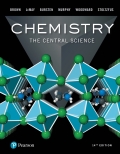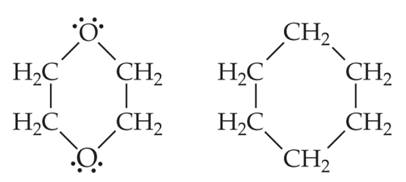
EBK CHEMISTRY:CENTRAL SCIENCE
14th Edition
ISBN: 9780134554570
Author: Brown
Publisher: PEARSON
expand_more
expand_more
format_list_bulleted
Concept explainers
Textbook Question
Chapter 13, Problem 31E
- Would you expect stearic acid, CH3 (CH2)16COOH, to be more soluble in water or in carbon tetrachloride?
- Which would you expect to be more soluble in water, cyclohexane or dioxane?


Expert Solution & Answer
Want to see the full answer?
Check out a sample textbook solution
Students have asked these similar questions
Please predict the products for each of the
following reactions.
Clearly show the regiochemistry (Markovnikov
vs anti-Markovnikov) and stereochemistry
(syn- vs anti- or both).
If a mixture of enantiomers is formed, please
draw all the enantiomers.
Hint: In this case you must choose the best
answer to demonstrate the stereochemistry of
H2 addition.
1.03
2. (CH3)2S
BIZ
CH₂OH
2. DMS
KMnO4, NaOH
ΖΗ
Pd or Pt (catalyst)
HBr
20 1
HBr
ROOR (peroxide)
HO
H-SO
HC
12 11 10
BH, THE
2. H2O2, NaOH
Brz
cold
HI
19
18
17
16
MCPBA
15
14
13
A
Br
H₂O
BH3⚫THF
Brz
EtOH
Pd or Ni (catalyst)
D₂ (deuterium)
1. Os04
2. H2O2
CH3CO3H
(peroxyacid)
1. MCPBA
2. H₂O*
H
B
+
H
H
H
"H
C
H
H
D
Explain how Beer’s Law can be used to determine the concentration in a selected food sample. Provide examples.
Explain the importance of having a sampling plan with respect to food analysis.
Explain the importance of having a sampling plan with respect to food analysis. Provide examples.
Chapter 13 Solutions
EBK CHEMISTRY:CENTRAL SCIENCE
Ch. 13.3 - Prob. 13.1.1PECh. 13.3 - Prob. 13.1.2PECh. 13.3 - Prob. 13.2.1PECh. 13.3 - Prob. 13.2.2PECh. 13.4 - Prob. 13.3.1PECh. 13.4 - Prob. 13.3.2PECh. 13.4 - Prob. 13.4.1PECh. 13.4 - Prob. 13.4.2PECh. 13.4 - Prob. 13.5.1PECh. 13.4 - Prob. 13.5.2PE
Ch. 13.4 - Prob. 13.6.1PECh. 13.4 - Prob. 13.6.2PECh. 13.5 - Prob. 13.7.1PECh. 13.5 - Prob. 13.7.2PECh. 13.5 - Which aqueous solution will have the lowest...Ch. 13.5 - Prob. 13.8.2PECh. 13.5 - Prob. 13.9.1PECh. 13.5 - Prob. 13.9.2PECh. 13.5 - Prob. 13.10.1PECh. 13.5 - Practice Exercise 2
Camphor (C10 H16 O) melts at...Ch. 13.5 - Prob. 13.11.1PECh. 13.5 - Prob. 13.11.2PECh. 13 - Prob. 1DECh. 13 - Rank the contents of the following containers in...Ch. 13 - This figure shows the interaction of a cation with...Ch. 13 - Consider two ionic solids, both composed of singly...Ch. 13 - Which two statements about gas mixtures are true?...Ch. 13 - Prob. 5ECh. 13 - 13.6 If you compare the solubilities of the noble...Ch. 13 - Prob. 7ECh. 13 - Prob. 8ECh. 13 - Prob. 9ECh. 13 - Prob. 10ECh. 13 - Suppose you had a balloon made of some highly...Ch. 13 - Prob. 12ECh. 13 - Indicate whether each statement is true or false:...Ch. 13 - Indicate whether each statement is true or false:...Ch. 13 - Indicate the type of solute-solvent interaction...Ch. 13 - Indicate the principal type of solute-solvent...Ch. 13 - An ionic compound has a very negative H soln in...Ch. 13 - When ammonium chloride dissolves in water, the...Ch. 13 - Prob. 19ECh. 13 - Prob. 20ECh. 13 - Prob. 21ECh. 13 - KBr is relatively soluble in water, yet its...Ch. 13 - The solubility of Cr (NO3)3 . 9 H2O in water is...Ch. 13 - The solubility of MnSO4 . H2 O in water at 20 C is...Ch. 13 - Prob. 25ECh. 13 - Prob. 26ECh. 13 - Prob. 27ECh. 13 - Prob. 28ECh. 13 - Prob. 29ECh. 13 - Prob. 30ECh. 13 - Would you expect stearic acid, CH3 (CH2)16COOH, to...Ch. 13 - Prob. 32ECh. 13 - Prob. 33ECh. 13 - Prob. 34ECh. 13 - Indicate whether each statement is true or false:...Ch. 13 - 13.36 Indicate whether each statement is true or...Ch. 13 - The Henry’s law constant for helium gas in water...Ch. 13 - Prob. 38ECh. 13 - Prob. 39ECh. 13 - Prob. 40ECh. 13 - Prob. 41ECh. 13 - Prob. 42ECh. 13 - 13.43 Calculate the morality of the following...Ch. 13 - Prob. 44ECh. 13 - Calculate the molality of each of the following...Ch. 13 - (a) What is the molality of a solution formed by...Ch. 13 - Prob. 47ECh. 13 - Prob. 48ECh. 13 - Prob. 49ECh. 13 - The density of toluene (C7H8) is 0.867 g\mL, and...Ch. 13 - Calculate the number of moles of solute present in...Ch. 13 - Calculate the number of moles of solute present in...Ch. 13 - Prob. 53ECh. 13 - Describe how you would prepare each of the...Ch. 13 - Commercial aqueous nitric acid has a density of...Ch. 13 - Prob. 56ECh. 13 - Prob. 57ECh. 13 - Prob. 58ECh. 13 - Prob. 59ECh. 13 - Prob. 60ECh. 13 - Prob. 61ECh. 13 - Prob. 62ECh. 13 - Consider two solutions, one formed by adding 10 g...Ch. 13 - Prob. 64ECh. 13 - Prob. 65ECh. 13 - (a) Calculate the vapor pressure of water above a...Ch. 13 - Prob. 67ECh. 13 - At 20 oC, the vapor pressure of benzene (C6 H6) is...Ch. 13 - Prob. 69ECh. 13 - Prob. 70ECh. 13 - Prob. 71ECh. 13 - Prob. 72ECh. 13 - Using data from Table 13.3, calculate the freezing...Ch. 13 - Prob. 74ECh. 13 - Prob. 75ECh. 13 - Prob. 76ECh. 13 - Prob. 77ECh. 13 - Prob. 78ECh. 13 - Prob. 79ECh. 13 - Lauryl alcohol is obtained from coconut oil and is...Ch. 13 - Prob. 81ECh. 13 - Prob. 82ECh. 13 - The osmotic pressure of a 0.010 M aqueous solution...Ch. 13 - Based on the given data in Table 13.4, which...Ch. 13 - (a) Do colloids made only of gases exist? Why or...Ch. 13 - Prob. 86ECh. 13 - An “emulsifying agent” is a compound that helps...Ch. 13 - Aerosols are important components of the...Ch. 13 - Prob. 89ECh. 13 - Soaps consist of compounds such as sodium state,...Ch. 13 - Prob. 91AECh. 13 - Prob. 92AECh. 13 - Most fish need at least 4 ppm dissolved O2 in...Ch. 13 - The presence of the radioactive gas radon (Rn) in...Ch. 13 - Prob. 95AECh. 13 - Prob. 96AECh. 13 - The maximum allowable concentration of lead in...Ch. 13 - Prob. 98AECh. 13 - Prob. 99AECh. 13 - Prob. 100AECh. 13 - Prob. 101AECh. 13 - The normal boiling point of ethanol, is 78.4 0C....Ch. 13 - Prob. 103AECh. 13 - Carbon disulfide (CS2) boils at 46.30 o C and has...Ch. 13 - Prob. 105AECh. 13 - Prob. 106IECh. 13 - At ordinary body temperature (37 o C), the...Ch. 13 - Prob. 108IECh. 13 - Prob. 109IECh. 13 - Prob. 110IECh. 13 - Prob. 111IECh. 13 - Prob. 112IECh. 13 - At 35 o C the vapor pressure of acetone, (CH3)2CO,...Ch. 13 - Prob. 114IE
Knowledge Booster
Learn more about
Need a deep-dive on the concept behind this application? Look no further. Learn more about this topic, chemistry and related others by exploring similar questions and additional content below.Similar questions
- Please predict the products for each of the following reactions. Clearly show the regiochemistry (Markovnikov vs anti-Markovnikov) and stereochemistry (syn- vs anti- or both). If a mixture of enantiomers is formed, please draw all the enantiomers. cold KMnO4, NaOH 2. DMS 1. 03 CH3OH Br2 1. 03 2. (CH3)2S H₂ Pd or Pt (catalyst) HBr 18 19 20 1 HBr ROOR (peroxide) H₂O H₂SO4 HCI HI 17 16 6 15 MCPBA 1. BH3 THF 2. H₂O2, NaOH 1. OsO4 2. H₂O₂ 110 CH3CO₂H (peroxyacid) 1. MCPBA 2. H₂O* Br2 H₂O BH3 THF B12 EtOH Pd or Ni (catalyst) D₂ (deuterium) Bra A B C D H OH H OH OH H OH α α α OH H OH OH фон d H "Harrow_forwardBriefly indicate the models that describe the structure of the interface: Helmholtz-Perrin, Gouy-Chapman, Stern and Grahame models.arrow_forwardElectrochemistry. Briefly describe the Gibbs model and the Gibbs absorption equation.arrow_forward
- Briefly state the electrocapillary equation for ideally polarized electrodes.arrow_forwardWhat is surface excess according to the Gibbs model?arrow_forwardUsing Benzene as starting materid show how each of the Following molecules Contel Ve syntheswed CHI 9. b -50311 с CHY 503H Ночто d. อ •NOV e 11-0-650 NO2arrow_forward
- The molecule PYRIDINE, 6th electrons and is therefore aromatre and is Assigned the Following structure contering Since aromatk moleculoy undergo electrophilic anomatic substitution, Pyridine shodd undergo The Following reaction + HNO3 12504 a. write all of the possible Mononitration Products that could Result From this reaction 18. Bared upon the reaction mechanison determime which of these producty would be the major Product of the hegetionarrow_forwarda. Explain Why electron withdrawing groups tend to be meta-Directors. Your answer Should lyclude all apropriate. Resonance contributing Structures fo. Explain why -ll is an outho -tura drccton even though chlorine has a very High Electronegativityarrow_forward9. Write Me product as well as the reaction Mechanism For each of the Following Vanctions +H₂504 4.50+ T C. +212 Fellz 237 b. Praw the potential energy Diagrams For each OF Mese Rauctions and account For any differences that appear in the two potential Puergy Diagrams which of here two reactions 19 Found to be Reversable, Rationalice your answer based upon the venation mechanisms and the potential energy diagrams.arrow_forward
arrow_back_ios
SEE MORE QUESTIONS
arrow_forward_ios
Recommended textbooks for you
 Chemistry: Principles and PracticeChemistryISBN:9780534420123Author:Daniel L. Reger, Scott R. Goode, David W. Ball, Edward MercerPublisher:Cengage Learning
Chemistry: Principles and PracticeChemistryISBN:9780534420123Author:Daniel L. Reger, Scott R. Goode, David W. Ball, Edward MercerPublisher:Cengage Learning Chemistry & Chemical ReactivityChemistryISBN:9781337399074Author:John C. Kotz, Paul M. Treichel, John Townsend, David TreichelPublisher:Cengage Learning
Chemistry & Chemical ReactivityChemistryISBN:9781337399074Author:John C. Kotz, Paul M. Treichel, John Townsend, David TreichelPublisher:Cengage Learning Chemistry & Chemical ReactivityChemistryISBN:9781133949640Author:John C. Kotz, Paul M. Treichel, John Townsend, David TreichelPublisher:Cengage Learning
Chemistry & Chemical ReactivityChemistryISBN:9781133949640Author:John C. Kotz, Paul M. Treichel, John Townsend, David TreichelPublisher:Cengage Learning Introduction to General, Organic and BiochemistryChemistryISBN:9781285869759Author:Frederick A. Bettelheim, William H. Brown, Mary K. Campbell, Shawn O. Farrell, Omar TorresPublisher:Cengage Learning
Introduction to General, Organic and BiochemistryChemistryISBN:9781285869759Author:Frederick A. Bettelheim, William H. Brown, Mary K. Campbell, Shawn O. Farrell, Omar TorresPublisher:Cengage Learning General Chemistry - Standalone book (MindTap Cour...ChemistryISBN:9781305580343Author:Steven D. Gammon, Ebbing, Darrell Ebbing, Steven D., Darrell; Gammon, Darrell Ebbing; Steven D. Gammon, Darrell D.; Gammon, Ebbing; Steven D. Gammon; DarrellPublisher:Cengage Learning
General Chemistry - Standalone book (MindTap Cour...ChemistryISBN:9781305580343Author:Steven D. Gammon, Ebbing, Darrell Ebbing, Steven D., Darrell; Gammon, Darrell Ebbing; Steven D. Gammon, Darrell D.; Gammon, Ebbing; Steven D. Gammon; DarrellPublisher:Cengage Learning Chemistry: Principles and ReactionsChemistryISBN:9781305079373Author:William L. Masterton, Cecile N. HurleyPublisher:Cengage Learning
Chemistry: Principles and ReactionsChemistryISBN:9781305079373Author:William L. Masterton, Cecile N. HurleyPublisher:Cengage Learning

Chemistry: Principles and Practice
Chemistry
ISBN:9780534420123
Author:Daniel L. Reger, Scott R. Goode, David W. Ball, Edward Mercer
Publisher:Cengage Learning

Chemistry & Chemical Reactivity
Chemistry
ISBN:9781337399074
Author:John C. Kotz, Paul M. Treichel, John Townsend, David Treichel
Publisher:Cengage Learning

Chemistry & Chemical Reactivity
Chemistry
ISBN:9781133949640
Author:John C. Kotz, Paul M. Treichel, John Townsend, David Treichel
Publisher:Cengage Learning

Introduction to General, Organic and Biochemistry
Chemistry
ISBN:9781285869759
Author:Frederick A. Bettelheim, William H. Brown, Mary K. Campbell, Shawn O. Farrell, Omar Torres
Publisher:Cengage Learning

General Chemistry - Standalone book (MindTap Cour...
Chemistry
ISBN:9781305580343
Author:Steven D. Gammon, Ebbing, Darrell Ebbing, Steven D., Darrell; Gammon, Darrell Ebbing; Steven D. Gammon, Darrell D.; Gammon, Ebbing; Steven D. Gammon; Darrell
Publisher:Cengage Learning

Chemistry: Principles and Reactions
Chemistry
ISBN:9781305079373
Author:William L. Masterton, Cecile N. Hurley
Publisher:Cengage Learning
Solutions: Crash Course Chemistry #27; Author: Crash Course;https://www.youtube.com/watch?v=9h2f1Bjr0p4;License: Standard YouTube License, CC-BY